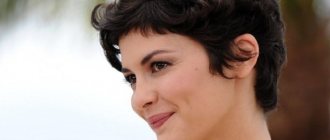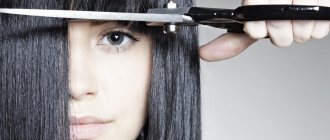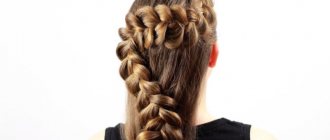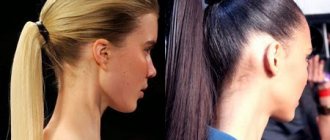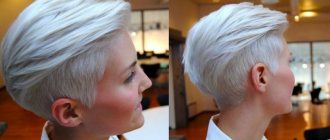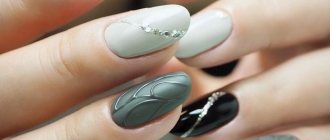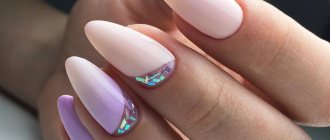Ideal ears: anatomical norms
The formation of the ear in the prenatal state begins at the end of the first trimester.
The auricle appears completely towards the end of pregnancy. The shape of these body parts is individual for everyone.
According to statistics, every second baby appears with protruding ears. This can be corrected before the age of six months, as the cartilage is elastic.
Most often, unattractive ear shapes begin to be noticed during adolescence. Parents bring their children to a plastic surgeon to correct the mistakes of nature. But surgery in childhood is performed only if there are indications for it.
Doctors have their own standards of symmetry, from which they build when diagnosing protruding ears:
- the distance between the edge of the ear and the skull should not exceed 20 mm;
- the angle of inclination should not exceed 30 degrees;
- Ideally, the ears are parallel to the cheeks.
If the ears do not stick out according to norms, then correction is carried out. There are several methods that can radically change a person’s face.
Suitable hairstyles for protruding ears
Protruding ears can be hidden from others. A well-chosen hairstyle will help you avoid complexes and ridicule from your peers. The hairdresser will help you choose the best option. Here are some tips you should listen to if you want to hide ugly protruding ears:
- Semi-long asymmetry is a bob or cap model. The hair will cover the problem area, and the image will become stylish and fashionable.
- You can't make your haircut too short. Hair should cover half of the ear.
- It is necessary to make a ponytail or braid from long hair not at the top of the head, but slightly below. This way, the hair will cover the ears.
- High hairstyles and buns, beloved by many ladies, can also be created. But at the same time, you should highlight the strands on the sides, with the help of which the view of the ears is blocked.
- Hair accessories can also cover up protruding ears. These are bandanas, scarves or rag headbands.
If the flaw is minor, then it is better to refuse the operation. Many people skillfully hide their protruding ears and do not have any complexes about it at all. Hairstyle can be a real salvation for girls.
Causes of protruding ears
At the moment, there are two main causes of protruding ears - heredity and congenital pathology. If we talk about protruding ears, the causes in most cases are hereditary. But do not think that if parents have ideally shaped ears, their child will also not have a similar defect. It can “inherit” them from grandparents and other relatives.
The second, no less common reason is the peculiarity of intrauterine development. Protruding ears are caused by a hypertrophied cartilaginous structure, flattened or underdeveloped antihelix. There are no other causes of a cosmetic defect. Prominent ears cannot develop due to various diseases or injuries. To date, there are no technologies or techniques to prevent the development of the defect.
Hairstyles covering the ears (photo)
Tail to one side
To avoid showing your ears, do your hair with a side ponytail. It is ideal for everyday looks, and if you add elegant hair accessories, it will also be appropriate for evening looks.
Of course, a high ponytail in this design will not work, but a low ponytail will look great too. Make a side parting, move all the hair to one side so that on the other side a strand covers your ear. The tail itself can be left straight, or lightly combed or curled for additional volume.
Greek style styling
These are romantic, gentle styling, slightly careless. We suggest making light waves on your hair, taking the front strands and pinning them at the back of your head. It is important not to pull the strands, let them fall relaxed on the face, covering the ears. The rest of your hair can be left loose or tied into a messy bun.
- Haircuts and hairstyles for faces with a high forehead: 55 current options that everyone can repeat
This styling is especially suitable for those girls who have curtain bangs. It will be easier to create a hairstyle that covers the ears if you place your bangs on a large round comb and leave a couple of strands in front.
"Waterfall"
The hairstyle is characterized by flowing curls from a braid braided across the head. “Waterfall” is easy to make yourself; it is suitable for any occasion and for different hair lengths. For an elegant look, you can weave a ribbon, a thread with rhinestones into your braid, or use bobby pins with pearls.
Which hair to use as a “waterfall” - straight or curled - is a matter of taste, but the hairstyle still looks better on wavy hair.
Messy bun
Is a bun not the best hairstyle for protruding ears? Yes, but not when we're talking about a messy bun. For greater effect, you can make curls or braid your hair at night. To create a messy bun, do not use a comb or pull the strands too tightly.
Stages of protruding ears
Protruding ears, depending on the level of protrusion, are divided into 3 main stages:
- First, the angle of departure of the auricle varies between 31-44°. The cosmetic defect is practically invisible to an outsider.
- The second is that the angle of departure is 44-45°. The shortcoming is clearly visible.
- The third is an angle of 90°, the defect immediately catches the eye.
In medicine, it is believed that the normal anatomical location of the auricle is 30° away from the head. How to get rid of: Protruding ears can be eliminated using two methods - surgical and conservative. The most effective method is an operation called otoplasty. It is best if surgical correction is performed in childhood, before reaching 7 years of age. The child’s body quickly recovers after the intervention, and the ears acquire a harmonious shape.
How to correct protruding ears if a person does not decide to undergo surgery and what to do if there are certain contraindications to surgery? There are special methods aimed at correcting protruding ears without surgery.
Non-surgical treatment methods
Protruding ears (or one ear) are a fairly common imperfection that can cause many complexes and unpleasant remarks from other people, especially among children. If ear deformity is noticeable from the first days of life, the abnormal shape and projection of the ear can be corrected without surgery using ear shaping techniques. In order for the correction to be successful, treatment must begin in the first 2 weeks of life. When correction of the defect is not possible due to severe deformation or late diagnosis, surgery may be required. If you notice that your baby has a protruding ear soon after birth, there is a less invasive treatment that can help correct the abnormality. To do this, use a special silicone device that is placed on the ear. With the help of this device, the correct shape of the auricle is formed within 3 weeks. The optimal time to start ear correction is the first month of life.
Symptoms
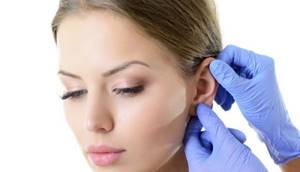
An otolaryngologist can confirm the presence of protruding ears. Such a defect is easy to determine yourself. If a problem is detected in a child, it is recommended to contact a specialist who will advise the most effective and safe method of solving it.
Sometimes aesthetic pathology is accompanied by deterioration of hearing, the appearance of acute pain and frequent otitis media.
The doctor prescribes a magnetic resonance examination and a series of tests to exclude chronic or infectious diseases.
Pixie with bangs
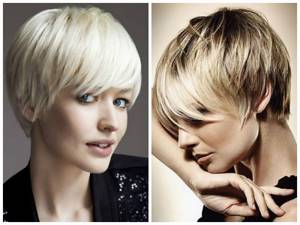
The hairstyle has layered edges and long bangs. This is a great way to create a shorter hairstyle that covers your ears subtly and naturally. The bangs flow into longer strands around the ears to frame the face and draw attention to the eyes and cheekbones.
Otoplasty
The most common and radical method of ear correction is plastic surgery. Woman.ru learned from Igor Bely, a surgeon, doctor of medical sciences and leading specialist at the Ottimo aesthetic surgery clinic , what types of this operation exist today. “Otoplasty can be reconstructive - to correct congenital defects, and it can be aesthetic - to correct the ugly size or shape of the ears. In each case, and taking into account the structural features of a particular person’s ears, the surgeon selects the necessary method of performing the operation, including the location of the incision,” says the doctor. You can reduce both the auricle itself and the angle formed by the ear and the surface of the head (in other words, correct protruding ears).
The head of the plastic surgery department of the Lapino Clinical Hospital and Candidate of Medical Sciences Denis Arkhipov told us about the mechanism of the intervention: “Plasty of the auricles consists of an incision behind the ear, cutting out part of the cartilage to change its shape and applying special sutures to form the required ear shape or position ear in relation to the head. The operation is usually performed from the age of six to seven years. Complications are possible, like any other operation, but the proven methodology and technology of the treatment process reduces the risks to minimal.”
Causes
Ear deformity is the most common ear developmental abnormality in children. The defect occurs due to excess cartilage tissue, abnormal location, or due to improper folding of the ear cartilage when the organ is formed. The ears may also appear asymmetrical due to their large deviation from the head, giving an unattractive appearance. The normal angle between the head and ear ranges from 10 to 25 degrees. The article presents an example of protruding ears in the photo.
Ear deformation can be unilateral or bilateral. Ears may be deformed or protruding from birth, or may lose their shape as a result of injury. This defect can occur in both children and adults. There are no statistical data that fully determine the occurrence of such an anomaly.

Sometimes parents blame themselves for their child's protruding ears because they allegedly leaned over while sleeping. Some try different types of patches in an attempt to bring the ears closer to the head. Of course, such attempts always end unsuccessfully. Protruding ears are a congenital deformity and cannot get worse or better, regardless of their position during sleep.
It is believed that 90% of ear growth and development is completed in the first 6 years of life, with the remaining 10% of growth occurring later in life. Therefore, correction of protruding ears, or otoplasty, can be done in the sixth year of a child’s life. Older people often notice disproportionately large ears as a result of aging. This occurs due to weakening and lengthening of the ear cartilage, loss of elasticity of the skin of the earlobe.
The best period for correcting protruding ears is preschool age. At this time, the child is not yet exposed to bullying and ridicule from peers. Consequently, the risk of psychological trauma and the development of an inferiority complex is minimal.
Laser or scalpel?
The incision can be made in two ways - with a scalpel or laser. What are the advantages of each of these methods? “In 90% of cases, otoplasty is performed with a laser,” explains Igor Bely. “Therefore, we can say that laser otoplasty does not exist as a separate type. The laser is less traumatic than a scalpel and allows the procedure to be carried out faster, but it is not always effective in the case of a specific patient and the structural features of his ears.” Denis Arkhipov agrees with his colleague: “The method does not have any special advantages; each method has certain conditions and indications. Unfair advertising often calls laser otoplasty “non-surgical,” but this is not true.”
The operation is performed under local or general anesthesia depending on the age, psychological status, desire of the patient and the scope of the operation. The recovery period lasts about one week, but sometimes it is necessary to wear an ear bandage for longer.
Haircuts for men

Protruding ears are often a source of low self-esteem and depression. While some undergo surgery, others prefer to hide the deformity in various ways, for example, with hats. In addition to caps, hats or hats, protruding ears can also be disguised with various hairstyles and haircuts. Men's haircuts for protruding ears are presented in the photo in this article.

Having protruding ears was not a problem in those days when men wore long hair. But shaved heads and ultra-short hairstyles came into fashion. Oblique bangs, asymmetrical strands, volume and negligence - all this will help correct the deficiency.

It is worth noting that a beautiful and well-groomed beard or sideburns can also distract from ear deformation.
How to get rid of protruding ears through surgery?
Surgical correction is the only completely effective way to get rid of a defect with a guaranteed result. The operation is called “otoplasty” and is performed from 6-7 years of age, including adults.
There are two methods of otoplasty – classic scalpel and laser. An incision about 4-5 cm long is made at the back of the ear. Through it, the cartilage is released, which is then trimmed and attached in a new place. When using a laser, manipulations are more precise and almost bloodless. After the operation, stitches, a bandage and an elastic bandage are applied. The procedure lasts about an hour under general anesthesia or local anesthesia.
Indications
Elimination of the defect by surgical intervention is indicated in the following cases:
- irregular shape;
- before the age of seven it was not possible to correct the shape using a conservative method;
- if the angle between the ear and the back of the head increases;
- smoothness of the antihelix and the anterior part of the auricle;
- asymmetry;
- psychological discomfort;
- injuries or ruptures of the auditory organ.
Changing the shape of the ear with surgery
Prominent-eared teenagers especially suffer from complexes. Therefore, parents often bring their children to a plastic surgeon to correct the situation.
Ideally, surgical intervention can be performed from the age of seven, at which age the cartilage tissue is fully formed.
Preparation for the operation is carried out within a week. The patient needs to undergo tests, ECG and fluorography. If no abnormalities are found, the person will undergo otoplasty. But this intervention has contraindications:
- diabetes;
- inflammatory diseases;
- tumors.
It is also necessary to inform the specialist about what medications the patient is currently taking. It is possible that some of them will have to stop drinking.
For example, Aspirin thins the blood, so it is prohibited to use it before any surgical interventions, so as not to provoke blood loss.
Otoplasty and postoperative period
The operation is performed using local anesthesia. For children, surgery is performed under general anesthesia.
If the child has problems with the heart, otoplasty will have to be abandoned.
The operation consists of an incision in the area located behind the ear. Excess cartilage tissue is removed and the shape is corrected. In modern clinics, lasers are used for manipulation.
Otoplasty lasts no more than an hour. During this time, excess cartilage is removed, correction is performed and a suture is applied. After surgery, patients complain of tingling, but there is no severe pain.
Two days after the intervention, slight swelling may form. An increase in temperature and severe pain is a reason to contact the clinic where the manipulations were performed. To achieve the desired result, the patient wears special rollers. The stitches are removed on the tenth day. During recovery, it is forbidden to wet the area where the incision was made. You can't get too cold yet.
How the operation goes: preparation, main stages
Correction can be performed through conventional or laser otoplasty.
After the consultation, when it has already been decided that the operation will be performed, diagnostic tests are prescribed, without receiving the results, the doctor will not be able to begin work.
Thus, the results of a general blood test, biochemical blood test, determination of blood group, screening of coagulation status, and necessarily HIV tests will be required. You will need to undergo an echocardiogram and fluorography.
Examination and planning involve photographing the ears, thinking through the future shape, position, etc., and only after this the date of surgical intervention is determined - surgery on the ears so that they do not stick out.
As noted above, the methods vary significantly, but the general principles (if we are talking about ordinary protruding ears) are as follows. First, an incision is made on the back of the ear, and the skin is separated from the cartilage, allowing access to the cartilage itself for correction. Next, if necessary, the position of the auricle is changed, for example, by securing the cartilage using absorbable sutures. Next, the cartilage is secured in its original position, excess tissue is removed, and sutures are applied.
Otoplasty in most cases lasts relatively short time and can take on average no more than 2 hours.
As for reconstructive plastic surgery, such manipulations take more time, and this is a rather complex process. Ears after reconstructive otoplasty:

Shift Back Method
Now to more specific, specific examples. The backward shift method is classic. Involves sterile processing of the operated area. A 2 cm incision is made on the back wall of the organ. The cartilage may be partially removed, or additional cartilage tissue taken from another part of the body may be used. They are formed in such a way that the auricle acquires the most aesthetic appearance. The stitches are small.
Laser otoplasty
Unlike conservative surgical methods, this type of otoplasty is performed using a laser beam. So, the operation has a number of advantages, including:
- During the manipulation itself, bleeding is minimized.
- Short recovery period.
- Low risk of postoperative complications, inflammatory processes, suppuration.
- Excellent aesthetic effect - scars are less pronounced.
Suture and seamless technique for correcting antihelix
How is suture otoplasty performed? The point is to apply a suture to artificially restore the antihelix or by modifying the cartilage. In this case, it is permissible to combine both technologies.
An incision is made on the back of the cartilage - this is a suture technique. Several sutures are placed to form the antihelix fold. In this case, the front wall is not affected. To avoid corrugation, horizontal seams are located close. A possible complication is deformation of the cartilage and upper part of the ear.
As for the seamless technique, based on the name, you can understand that when corrugating cartilage, no sutures are applied. The technique consists of making an incision behind the organ and administering special injections, which leads to the destruction of cartilage. This, in turn, causes the structures to take the correct position.
Review of haircuts for hair of different lengths
A women's cascade haircut involves uneven, graduated strands on the sides. Chaotically styled, tousled hair can hide many imperfections. The hairstyle is suitable for young ladies who have protruding ears, an imperfect oval shape, wide cheekbones, and a high forehead. The strands of the face emphasize the features, giving them symmetry and expressiveness.
A cascade on short curls is suitable for girls with thick and curly hair. A good option for mature women, the model has a rejuvenating effect.
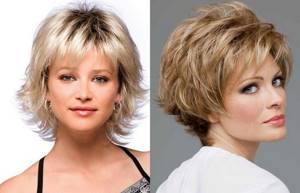
The stylish “Cap” is suitable for slender, tall young ladies with thick curls. Requires frequent adjustments by the master, as well as daily styling. It may have an asymmetrical shape or be performed at the same level. Suitable for oblong, triangular and regular ovals. You can use monochrome coloring or add interesting shades of contrasting tones to the main color.
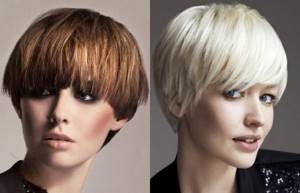
A graduated bob on short hair will be an excellent solution for correcting protruding ears. The combination with long, asymmetrical bangs allows you to create feminine, elegant hairstyles. Can be done on straight, curly hair, experimenting with different coloring techniques. The hairstyle is suitable for mature ladies who want to look stylish and modern.
Note! A haircut is recommended for round, square, diamond-shaped faces; the model visually elongates the face and gives the correct proportions.
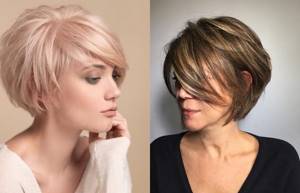
A medium length bob without bangs is a basic universal hairstyle. Suitable for young ladies, as well as women over 40. You can make different shapes with graphic cuts or soft transitions, the option depends on the type of face. Asymmetrical models look great on smooth, thick curls; it is better to give thin, unruly strands the desired shape using graduations. Falling hair visually lengthens the face; bob variations are suitable for girls with imperfect features. Thanks to the side parting and soft waves, it is possible to achieve the correct proportions.
Alternative Methods
In our country today there are no operations that constitute an alternative to otoplasty, but in the West they exist. “The method of ear correction using gold clips is beginning to become widespread abroad. They are placed under the skin on the cartilage,” says Igor Bely. — This method is less traumatic compared to conventional otoplasty, but also more expensive. It is not yet certified in Russia.”
Ear correctors: pros and cons
While overseas methods of correcting the structure of the ear have not reached us, many do not dare to undergo plastic surgery, even despite its relative safety, and resort to non-invasive methods of correcting the auricle. Yes, yes, there are those too! The device is called “ear correctors”, and we wonder why they still don’t compete with posture correctors and weight loss corsets on Instagram.
Braided side ponytail
This simple and unobtrusive hairstyle is suitable for every day. It can be combined with literally any outfit - a business trouser suit, jeans or a dress. Each of you can do this hairstyle. In addition, you don’t need any expensive accessories for it - just a simple brush and a hair tie.
1. Comb your hair to the side – your hair should be absolutely smooth.
2. Take one strand 5 cm wide from the front of your head. Braid it into a braid, tie the end with a silicone elastic band.
3. Pass the finished braid under the total mass of hair.
4. Throw everything on its side and carefully wrap this ponytail along its entire length with a pigtail. Make sure that the strands on the other side tightly cover your ear.
5. Secure the tip again with silicone rubber.
6. Spray everything with varnish.
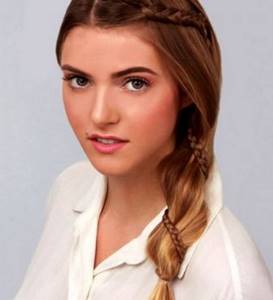
How to choose a correction method
To understand how to get rid of protruding ears, you need to carefully study your problem. Correction methods depend on the following factors:
- degree of severity of the defect (there are 3 in total);
- age;
- desired result.
It is worth noting right away that ear correction without surgery may not give the expected result or be completely useless in some situations. However, do not despair, in most cases this problem can be skillfully disguised, for example, with the help of a hairstyle.
Correcting a defect without surgery
How to get rid of protruding ears without surgery? The non-surgical method is also quite effective if used regularly. Today the pharmacological market offers a lot of ways:
- Corrector Arilis (Russian-Finnish production) is an effective correction of protruding ears in children and adults. The corrector is made of silicone and allows you to get rid of imperfections at any age, but the period of wearing it is quite long. For children - several months, for adults it is calculated in years. In this case, the corrector must be replaced every 10 days.
- The corrector Otostik (Spanish production) will help you get rid of protruding ears - it is available in two series, for adults and children aged 3 months and older. The silicone product completely follows the anatomical shape of the auricle; it is attached to the head using a special hypoallergenic glue, which is also included in the kit.
- The Oto-plastic corrector is an analogue of the previous product with the same principle of use. Produced in two lines - for men and women. The product is attached to the ear for 2 days, after which it requires replacement.
Regularly wearing a corrector in childhood can completely eliminate protruding ears; in adults, it can make the cosmetic defect as invisible as possible. The main function of a corrector for adults is to make protruding ears visually invisible and allow a person to lead a normal, fulfilling lifestyle. The corrector can be worn for 7 days, after which it must be replaced with a new one.
Correctors for protruding ears
Nowadays, many correctors are offered to get rid of protruding ears. They all have a similar design and a similar principle of operation. The accessory consists of two transparent silicone parts that are fastened together and are invisible when worn. All brands of products work the same. The slight differences are in the attachment method and wearing comfort. A separate corrector is glued to the skin of the ear with a special hypoallergenic glue, and the other part is glued to the head. When fastened together, the two parts of the corrector give the ear the correct shape, pressing it to the temples. After some time, the cartilage takes on the desired position, and you no longer need to wear a corrector.
Types of correctors
The main conservative methods include:
- Ear bandage . It is used in early infancy, when all the cartilage is still soft, elastic and subject to changes. Minor protruding ears can be corrected by an ordinary cap or cap. Some mothers use a scarf or bandage. In a newborn child, bandages on the ears can also be used to prevent protruding ears.

- Correctors Arilis . The product is suitable for children and adults. According to the manufacturer, it will allow you to get rid of protruding ears at any age, the main thing is to wear the correctors for a sufficient period of time. The company’s official website states: “In children from birth, significant results are noticeable after just 3 months of wearing ear correctors. In an adult, due to the fact that the ear cartilage is already formed and more rigid than in a child, changes occur after 2 years of continuous wearing of correctors.” The cost of the products is: 4 pieces - 950 rubles, 10 pieces - 1690 rubles.
Haircuts that hide ears
You shouldn’t write off the various haircuts that can cover your ears neatly and very stylishly. These include all kinds of bobs (even, asymmetrical), bob and bob hairstyles. By the way, these are the haircuts that can have medium length hair.
The same should be said about such haircuts as page and sesson. They also cover the ears well and are suitable for medium-length hair. You just need to remember about regular visits to the hairdresser to maintain your hair at the proper level (neat and elegant).

Another haircut that can easily cover protruding ears is the cascade style haircut. Even if you put your hair in a ponytail, there will be enough strands to let them out near your temples and cover all the imperfections that you want to hide.

Now you know some beautiful and original hairstyles for medium hair to cover your ears. In addition, you can make a suitable haircut that will also cover your ears (there’s less fuss with it, there’s no need to do complicated hairstyles). In any case, regardless of what you choose, you should remember the main rules for masking such defects - loose strands, various side braids, low buns. Using this knowledge, you will be simply irresistible!
At what age is correction of protruding ears recommended?
Surgical correction is usually recommended after five years. By this age, the ears will be practically formed, although they will continue to grow. Excision of excess cartilage with a scalpel can be performed on a child no earlier than six years of age, and preferably after eight years. If the deformation is significant, then it is better to correct it before school to avoid problems with the child’s socialization. Home and other non-surgical methods can be tried at any age.
We correct ears for children under six months old
If a baby's ears stick out, how to correct the situation without surgery must be decided very quickly. Up to 6 months, the cartilage is still very plastic and can be corrected. Then your child may not even know that after birth he had aesthetic defects.
Silicone ear pads are made especially for the smallest toddlers. They allow you to fix the sinks in the correct position and, with constant use for six months, can completely eliminate the problem.
Advantages:
- do not cause discomfort to the baby;
- easy to use;
- give good results;
- do not cause allergies or irritation.
Some parents try to glue their babies' ears to their heads with adhesive tape because they think this will help eliminate the defect. The result can indeed be positive, but such methods can also have side effects, for example:
- curvature of the auricle;
- hearing impairment;
- irritation of delicate skin.
From this it follows that correction of protruding ears without surgery should be carried out only with the help of certified means. Common household items can harm a child.
Elimination of defects for children under 7 years of age
When the auricle becomes less flexible, correction of protruding ears without surgery is much more difficult and requires the use of special equalizers.
You can find such devices from Spanish manufacturers, they are called Otostick. Also on the market is a similar product “Aralis”. They were developed by Russian and Finnish doctors. The correctors are almost identical, you can choose the one that will be more affordable for you. The device in the form of a silicone equalizer is treated with a special hypoallergenic glue, and it is on this that we will “plant” the protruding ears.
Small transparent plates are attached to the head and the ears are pressed against them. The principle of their operation is similar to double-sided tape. They are suitable for children from 3 months, there is also a series for adults. The only difference is that children can still get rid of the defect to some extent, but after 7 years, equalizers can only mask the problem.
Advantages of use:
- noticeable result;
- hypoallergenic materials;
- long period of use (1 pair can be worn for 7 days, sometimes it lasts longer);
- invisibility to others;
- versatility, you can wear them in the pool, wash your hair with them, or take a shower.
Flaws:
- quite high cost - 1 set will cost you from several thousand rubles;
- impossibility of correcting defects 100%.
Ear correction for adults
If you have protruding ears, you have probably wondered more than once how to get rid of this problem without surgery. After 7 years, the ear cartilages are fully formed, which is why doctors allow otoplasty to be performed at this age. Without surgery, it will not be possible to completely eliminate the defect. You can constantly walk around in baseball caps and headbands, put on a hat that fits tightly to your head at night, but this will not give any results.
In adults, protruding ears can only be masked; it cannot be eliminated by any conservative methods.
For this you can use:
- ear correctors;
- hats and accessories;
- voluminous hairstyles.
Important! If you experience discomfort, pain or tightness when wearing a hat or accessory that covers your ears for long periods of time, do not continue to do so. Poor circulation can lead to serious health problems.
For long
Long and beautiful hair is the calling card of any woman. Properly chosen hairstyles will help not only make them even more attractive, but also hide the problem with the ears.
Loose
Long hair is a source of pride. Wearing them constantly in this state is problematic, but sometimes you can afford such pleasure.

For this option, you need to constantly monitor the health of your hair.
With braids
There are a large number of braided hairstyles that are specifically designed to cover the ear area.
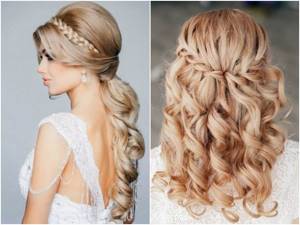
The combination and interweaving of several braids will create an original image.
Babette
Curls styled in a babette are gathered into a roll at the back and partly at the top of the head. There are hairstyle options with both open and closed ears.
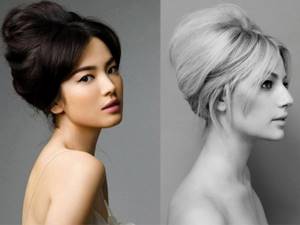
You can cover the problem area if you use the option in which the front strands fall around the face
Bun
The principle of hairstyle formation for those with protruding ears is the same - the front strands cover the problem area and are included in the total mass of hair that forms the bun.
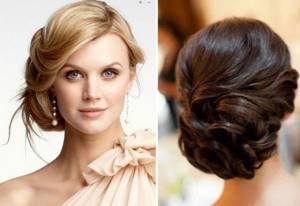
The bun can be careless, smooth, low or high
Shell
Only girls with long hair can afford this option, since it won’t work out well on short hair.
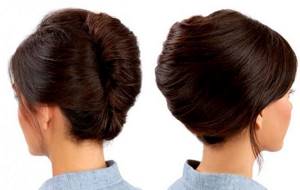
To hide your ears, you should place the shell at the bottom of your head, closer to the back of the head, and cover the problem area with the front strands
Greek
Girls with Greek hairstyles look especially feminine. To create the image, you need to prepare the headband in advance. It should have a length that suits your specific hair and overall appearance.

Greek hairstyle is often done for weddings
There are many hairstyles for hair of any length that will help cover protruding ears. The variety of options will allow you to choose the most suitable style for each woman.
